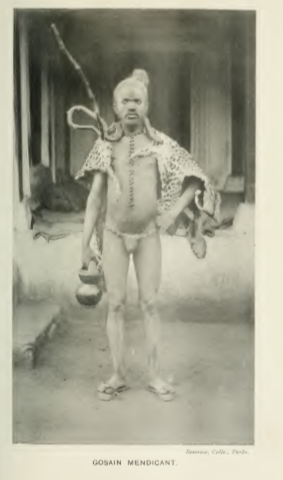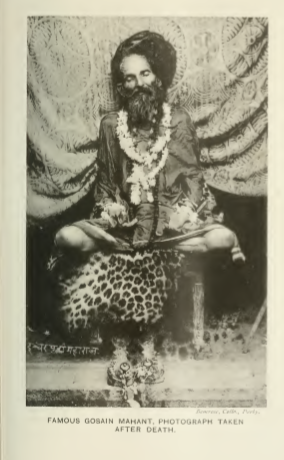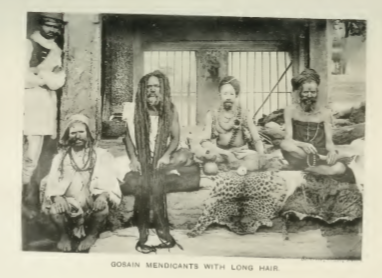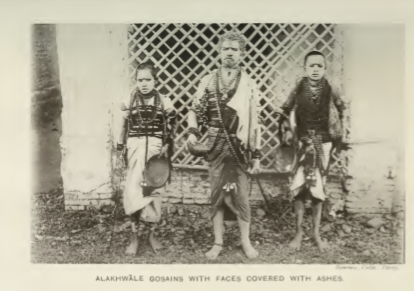Gosain
This article was written in 1916 when conditions were different. Even in Readers will be able to edit existing articles and post new articles directly |
From The Tribes And Castes Of The Central Provinces Of India
By R. V. Russell
Of The Indian Civil Service
Superintendent Of Ethnography, Central Provinces
Assisted By Rai Bahadur Hira Lal, Extra Assistant Commissioner
Macmillan And Co., Limited, London, 1916.
NOTE 1: The 'Central Provinces' have since been renamed Madhya Pradesh.
NOTE 2: While reading please keep in mind that all articles in this series have been scanned from the original book. Therefore, footnotes have got inserted into the main text of the article, interrupting the flow. Readers who spot these footnotes gone astray might like to shift them to their correct place.
Gosain
the process of mortification is complete he should beg his bread as a Sanniasi.
But only those who enter the religious orders now become Sanniasis, and the name is therefore confined to them. Dasnami means the ten names, and refers to the ten orders in which the Gosains or Sivite anchorites are commonly classified. Sadhu is a generic term for a religious mendicant. The name Gosain is now more commonly applied to the married members of the caste, who pursue ordinary avocations, while the mendicants are known as Sadhu or Sanniasi. The Gosains consider their founder to have been Shankar 2. The ten Acharya, the great apostle of the revival of the worship of orders- Siva in southern India, who lived between the eighth and tenth centuries. He had four disciples from whom the ten orders of Gosains are derived. These are commonly stated as follows :
1. Giri (peak or top of a hill).
2. Puri (a town).
3. Parbat (a mountain). 4. Sagar (the ocean). 5. Ban or Van (the forest).
6. Tlrtha (a shrine of pilgrimage).
7. Bharthi (the goddess of speech).
8. Saraswati (the goddess of learning). 9. Aranya (forest). 10. Ashram (a hermitage).
The names may perhaps be held to refer to the different places in which the members of each order would pursue their austerities. The different orders have their head- quarters at great shrines.
The Saraswati, Bharthi and Puri orders are supposed to be attached to the monastery at Sringeri in Mysore ; the Tlrtha and Ashram to that at Dwarka in Gujarat ; the Ban and Aranya to the Govardhan monastery at Puri ; and the Giri, Parbat and Sagara to the shrine of Badrinath in the Himalayas. Dandi is sometimes shown as one of the ten orders, but it seems to be the special designation of certain ascetics who carry a staff and may belong to either the Tlrtha, Ashram, Bharthi or Saraswati groups.
Another name for Gosain
ascetics is Abdhut, or one who has separated himself from the world. The term Abdhut is sometimes specially applied to followers of the Maratha saint, Dattatreya, an incarnation of Siva. The commonest orders in the Central Provinces are Giri, Puri and Bharthi, and the members frequently use the name of the order as their surname. Members of the Aranya, Sagara and Parbat orders are rarely met with at present.
3 . initia- A notice of the Gosains who have become an ordinary tion
- caste will be given later. Formerly only Brahmans or members of the twice-born castes could become Gosains, but now a man of any caste, as Kurmi, Kunbi or Mali, from whom a Brahman takes water, may be admitted. In some localities it is said that Gonds and Kols can now be made Gosains, and hence the social position of the Gosains has greatly fallen, and high- caste Hindus will not take water from them. It is supposed, however, that the Giri order is still recruited only from Brahmans.
At initiation the body of a neophyte is cleaned with the five products of the sacred cow, milk, curds, g/iz, dung and urine. He drinks water in which the great toe of his guru has been dipped and eats the leavings of the latter's food, thus severing himself from his own caste. His sacred thread is taken off and broken, and it is sometimes burned and he eats the ashes. All the hair of his head is shaved, including the scalp-lock, which every secular Hindu wears. A mantra or text is then whispered or blown into his ear. 4. Dress. The novice is dressed in a cloth coloured with geru or red ochre, such as the Gosains usually wear.
It is probable that the red or pink colour is meant to symbolise blood and to signify that the Gosains allow the sacrifice of animals and the consumption of flesh, and on this account they are called Lai Padri or red priest, while Vishnuite mendicants, who dress in white, are called Slta Padri. He has a necklace or rosary of the seeds of the rudrakhsa tree,1 sacred to Siva, consisting of 32 or 64 beads. These are like nuts with a rough indented shell. On his forehead he marks with bhabhut or ashes three horizontal lines to 1 Elaeocarptis.
represent the trident of Siva, or sometimes the eye of the god. Others make only two lines with a dot above or below, and this sign is said to represent the phallic emblem. A crescent moon or a triangle may also be made.1 The marks are often made in sandalwood, and the Gosains say that the original sandalwood grows on a tree in the Himalayas, which is guarded by a great snake so that nobody can approach it ; but its scent is so strong that all the surrounding trees of the grove are scented with it and sandalwood is obtained from them. Those who worship Bhairon make a round mark with vermilion between the eyes, taking it from beneath the god's foot.
A mendicant usually has a begging- bowl and a pair of tongs, which are useful for kindling a fire. Those who have visited Badrinath or one of the other Himalayan shrines have a ring of iron, brass or copper on the arm, often inscribed with the image of a deity. If they have been to the temple of Devi at Hinglaj in the Lasbela State of Beluchistan they have a necklace of little white stone beads called thumra ; and one who has made a pilgrimage to Rameshwaram at the extreme southern point of India has a ring of conch -shell on the wrist.
When he can obtain it a Gosain also carries a tiger- or panther-skin, which he wears over his shoulders and uses to sit and lie down on.
Among the ancient Greeks it was the custom to sleep in a temple or its avenue either on the bare ground or on the skin of a sacred animal, in order to obtain visions or appearances of the god in a dream or to be cured of diseases.2 Formerly the Gosains were accustomed to go about naked, and at the religious festivals they would go in procession naked to bathe in the river. At Amarnath in the Punjab they would throw themselves naked on the block of ice which represented Siva.3 The Naga Gosains, so called because they were once accustomed to go naked into battle, were a famous fighting corps. Though they shave the head and scalp-lock on initiation the Gosains usually let the hair grow, and either have it hanging down 1 Mr. Marten's C.P. Census Report 3 Oman, Mystics, Ascetics and (191 1), p. 79. Saints, p. 269. - Orphhts, p. 137.
in matted locks over the shoulders, which gives them a wild and unkempt appearance, or wind it on the top of the head into a coil often thickened with strips of sheep's wool. They say that they let the hair grow in imitation of the ancient forest ascetics, who could not but let it grow as they had no means to shave it, and also of the matted locks of the god Siva.
Sometimes they let the hair grow during the whole period of a pilgrimage, and on arrival at the shrine of their destination shave it off and offer it to the god. Those who are initiated on the banks of the Nerbudda 5. Methods throw the hair cut from their head into the sacred river. They have various rules about begging.
Some will and greet- J t>o & ings. never turn back to receive alms. They may also make a rule only to accept the surplus of food cooked for the family, and to refuse any of special quality or cooked expressly for them. One Gosain, noticed by Mr. A. K. Smith, always begged hopping, and only from five houses ; he took from them respectively two handfuls of flour, a pinch of salt, and sufficient quantities of vegetables, spices and butter for his meal, and then went hopping home. Those who are performing the perikrama or circuit of the Nerbudda from its source to its mouth and back, do not cut their hair or nails during the whole period of about three years. They may not enter the Nerbudda above their knees nor wash their vessels in it.
After crossing any tributary river or stream in their path they may not re-cross this ; and if they have forgotten or left any article behind, must abandon it unless they can persuade somebody to go back and fetch it for them. Some carry a gourd with a single string stretched on a stick, on which they twang some notes ; others have a belt of sheep's hair hung with the bells of bullocks which they tie round the waist, so that the tinkling of the bells may announce their coming. A common begging cry is Alakh, which is said to mean ' apart,' and to refer to themselves as being apart or separated from the world. The beggar gives this cry and stands at the door of the house for half a minute, shaking his body about all the time. If no alms are brought in this time he moves on. When an ordinary Hindu meets a Gosain he says ' Namu Narayan ' or ' I go to Narayan,' and the Gosain
answers ' Narayan.' Narayan is a name of Vishnu, and its use by the Gosains is curious. Those who have performed the circuit of the Nerbudda say ' Har Nerbudda,' and the person addressed answers ' Nerbudda Mai ki Jai ' or ' Victory to Mother Nerbudda.' The Dandis are a special group of ascetics belonging 6. The to several of the ten orders. According to one account a novice who desires to become a Sanniasi must serve a period of probation for twelve years as a Dandi. Others say that only a Brahman can be a Dandi, while members of other castes may become Sanniasis, and a Brahman can only become one if he is without father, mother, wife or child.
1 The Dandi is so called because he has a dand or bamboo staff like the ancient Vedic students. He must always carry this and never lay it down, but when sleeping plant it in the ground. Sometimes a piece of red cloth is tied round the staff. The Dandi should live in the forest, and only come once a day to beg at a Brahman's house for a part of such food as the family may have cooked.
He should not ask for food if any one else, even a dog, is waiting for it. He must not accept money, or touch fire or any metal. As a matter of fact these rules are disregarded, and the Dandi frequents towns and is accompanied by companions who will accept all kinds of alms on his behalf.2 Dandis and Sanniasis do not worship idols, as they are themselves considered to have become part of the deity. They repeat the phrase ' Sevoham,' which signifies ' I am Siva.' Another curious class of Gosains are the Rawanvansis, who go about in the character of Rawan, the demon king of i- The Ceylon, as he was when he carried off Slta.
The legend is vansj s . that in order to do this, Rawan first sent his brother in the shape of a golden deer before Rama's palace. Slta saw it and said she must have the head of the deer, and sent Rama to kill it. So Rama pursued it to the forest, and from there Rawan cried out, imitating Rama's voice. Then Slta thought Rama was being attacked and told his brother Lachman to go to his help. But Lachman had been left 1 Bhattacharya, Hindu Castes and Mystics, Ascetics and Saints, pp. 160, Sects, p. 3 So. 161. - Bhattacharya, ibidem, and Oman,
8. Monas-
teries.
9. The fighting Gosains. in charge of her by Rama and refused to leave her, till Sita said he was hoping Rama would be killed, so that he might marry her. Then he drew a circle round her on the ground, and telling her not to step outside it until his return, went off. Then Rawan took the disguise of a beggar and came and begged for alms from Sita. She told him to come inside the magic circle and she would give him alms, but he refused. So finally Sita came outside the circle, and Rawan at once seized her and carried her off to Ceylon.
The Rawanvansi Gosains wear rings of hair all up their arms and a rope of hair round the waist, and the hair of their head hanging down. It would appear that they are intended to represent some animal. They smear vermilion on the forehead, and beg only at twilight and never at any other time, whether they obtain food or not. In begging they will never move backwards, so that when they have passed a house they cannot take alms from it unless the householder brings the gift to them. Unmarried Sanniasis often reside in Maths or monasteries. The superior is called Mahant, and he appoints his successor by will from the members.
The Mahant admits all those willing and qualified to enter the order. If the applicant is young the consent of the parents is usually obtained ; and parents frequently vow to give a child to the order. Many convents have considerable areas of land attached to them, and also dependent institutions. The whole property of the convent and its dependencies seems to be at the absolute disposal of the Mahant, but he is bound to give food, raiment and lodging to the inmates, and he entertains all travellers belonging to the order.1
In former times the Gosains often became soldiers and entered the service of different military chiefs. The most famous of these fighting priests were the Naga Gosains of the Jaipur State of Rajputana, who are said to have been under an obligation from their guru or religious chief to fight for the Raja of Jaipur whenever required. They received rent-free lands and pay of two pice (|d.) a day, which latter was put into a common treasury and expended on the purchase of arms and ammunition whenever needed
for war. They would also lend money, and if a debtor could not pay would make him give his son to be enrolled in the force. The 7000 Naga Gosains were placed in the vanguard of the Jaipur army in battle. Their weapons were the bow, arrow, shield, spear and discus. The Gosain proprietor of the Deopur estate in Raipur formerly kept up a force of Naga Gosains, with which he used to collect the tribute from the feudatory chiefs of Chhattlsgarh on behalf of the Raja of Nagpur. It is said that he once invaded Bastar with this object, where most of the Gosains died of cholera.
But after they had fasted for three days, the goddess Danteshwari appeared to them and promised them her protection. And they took the goddess away with them and installed her in their own village in Raipur. Forbes records that in Gujarat an English officer was in command of a troop known as the Gosain's wife's troops. These Naga Gosains wore only a single white garment, like a
sleeveless shirt reaching to the knees, and hence it is said that they were called naked.
The Gosains and Bairagis, or adherents of Siva and Vishnu, were often engaged in religious quarrels on the merits of their respective deities, and some- times came to blows. A favourite point of rivalry was the right of bathing first in the Ganges on the occasion of one of the great religious fairs at Allahabad or Hardwar.
The Gosains claim priority of bathing, on the ground that the Ganges flows from the matted locks of Siva ; while the Bairagis assert that the source of the river is from Vishnu's foot. In 1760 a pitched battle on this question ended in the defeat of the Bairagis, of whom 1800 were slain. Again in 1796 the Gosains engaged in battle with the Sikh pilgrims and were defeated with the loss of 500 men.
1 During the reign of Akbar a combat took place in the Emperor's presence between the two Sivite sects of Gosains, or Sanniasis and Jogis, having been apparently arranged for his edification, to decide which sect had the best ground for its pretensions to supernatural power. The Jogis were completely defeated.2 1 Nesfield, Brief View of the Caste Superstitions of India (London, T. System, p. 86. Fisher Unwin), p. 11. 2 J. C. Oman, Cults, Customs and
10. Burial. A dead Sanniasi is always buried in the sitting attitude of religious contemplation with the legs crossed. The grave may be dug with a side receptacle for the corpse so that the earth, on being filled in, does not fall on it The corpse is bathed and rubbed with ashes and clad in a new reddish- coloured shirt, with a rosary round the neck. The begging- wallet with some flour and pulse are placed in the grave, and also a gourd and staff. Salt is put round the body to preserve it, and an earthen pot is put over the head. Sometimes cocoanuts are broken on the skull, to crack it and give exit to the soul.
Perhaps the idea of burial and of preserving the corpse with salt is that the body of an ascetic does not need to be purified by fire from the appetites and passions of the flesh like that of an ordinary Hindu ; it is already cleansed of all earthly frailty by his austerities, and the belief may therefore have originally been that such a man would carry his body with him to the afterworld or to absorption with the deity. The burial of a Sanniasi is often accompanied with music and signs of rejoicing ; Mr. Oman describes such a funeral in which the corpse was seated in a litter, open on three sides so that it could be seen ; it was tied to the back of the litter, and garlands of flowers partly covered the body, but could not conceal the hideousness of death as the unconscious head rolled helplessly from side to side with the movement of the litter.
The procession was headed by a European brass band and by men carrying censers of incense. 1 Sexual Celibacy is the rule of the Gosain orders, and a man's property passes in inheritance to a selected chela or disciple. But the practice of keeping women is very common, even outside the large section of the community which now recognises marriage. Women could be admitted into the order, when they had to shave their heads, assume the ochre- coloured shirt and rub their bodies with ashes. Afterwards, with the permission of the guru and on payment of a fine, they could let their hair grow again, at least temporarily. These women were supposed to remain quite chaste and live in nunneries, but many of them lived with men of the order. It is not known to what extent women are admitted at
present. The sons born of such unions would be adopted as chelas or disciples by other Gosains, and made their heirs by a reciprocal arrangement. Women who are convicted of some social offence, or who wish to leave their husbands, often join the order nominally and live with a Gosain or are married into the caste. Many of the wandering mendicants lead an immoral life, and scandals about their enticing away the wives of rich Hindus are not infrequent. 1 During their visits to villages the)/ also engage in intrigues, and a ribald Gond song sung at the Holi festival describes the pleasure of the village women at the arrival of a Gosain owing to the sexual gratification which they expected to receive from him.
Nevertheless the wandering Gosains have done much to 12. Mis- foster and maintain the Hindu religion among the people. sum**y They are the gurus or spiritual preceptors of the middle and lower castes, and though their teaching may be of little advantage, it perhaps quickens and maintains to some extent the religious feelings of their clients. In former times the Gosains travelled over the wildest tracts of country, pro- selytising the primitive non-Aryan tribes, for whose conversion to Hinduism they are largely responsible. On such journeys they necessarily carried their lives in their hands, and not infrequently lost them.
The majority of the Gosains are, however, now married 13. The and form an ordinary caste. Buchanan states that the ten c.°te' n different orders became exogamous groups, the members of which married with each other, but it is doubtful whether this is the case at present. It is said that all Giri Gosains marry, whether they are mendicants or not, while the Bharthi order can marry or not as they please.
They prohibit any marriage between first cousins, but permit widow remarriage and divorce. They eat the flesh of all clean animals and also of fowls, and drink liquor, and will take cooked food from the higher castes, including Sunars and Kunbis. Hence they do not rank high socially, and Brahmans do not take water from them, but their religious character gives them some prestige. Many Gosains have become landholders, obtaining their estates either as charitable grants from clients or through moneylending transactions. In this capacity they do not 1 Sir E. Maclagan, Punjab Census Report (1S91), p. 112. caste.
usually turn out ,/ell, and are often considered harsh land- lords and grasping creditors.
This section has been extracted from THE TRIBES and CASTES of BENGAL. Ethnographic Glossary. Printed at the Bengal Secretariat Press. 1891. . |
NOTE 1: Indpaedia neither agrees nor disagrees with the contents of this article. Readers who wish to add fresh information can create a Part II of this article. The general rule is that if we have nothing nice to say about communities other than our own it is best to say nothing at all.
NOTE 2: While reading please keep in mind that all posts in this series have been scanned from a very old book. Therefore, footnotes have got inserted into the main text of the article, interrupting the flow. Readers who spot scanning errors are requested to report the correct spelling to the Facebook page, Indpaedia.com. All information used will be gratefully acknowledged in your name.
Gosain
Goszoami, Gonsai, Gonsia, a master of his passions, a religious mendicant; a title of a class of Brahmans, the original disciples of Chaitanya, who are spiritual guides of the wor¬shippers of Vishnu. In Bengal the term is usually applied to J ugis and the Grilli or Grihastha Vaishnavas, who are allowed to marry and follow secular PUT¬suits. Itis also used as a com¬mon title, just as Banarji, Bhat¬tacharji, etc. Socially it de¬notes a class of people who manufactUTe and sell threads, corresponding to J ugis. A synonym for Bairagi.



